It looks like you're using an Ad Blocker.
Please white-list or disable AboveTopSecret.com in your ad-blocking tool.
Thank you.
Some features of ATS will be disabled while you continue to use an ad-blocker.
32
share:
First, i'll have to say it is not entirely clear if there is a mystery at all. But, with a title claiming there is, i know it is bit anticlimactic to
relativize the initial premise and therefore, the purpose of the thread. The reason for this is the lack of reliable information, documentation and
missing crucial evidence. That would be in itself one aspect of this two-fold mystery. Even after a reasonably exhaustive search for all relevant
details, i was unable to conclusively verify the determining facts. Having said that, the claim that there is indeed a mystery surrounding the persian
tombs, remains open for discussion.
- Backround
The persian tombs ( saite tombs, persian shafts) are located to the south of the Unas Pyramid in northern Saqqara, 15km south of Giza. The tombs are attributed to three officials of 26th dynasty (late period, ca. 670-330 BC) namely, Djenhebu -‘Overseer of Royal Freight Boats’, Psamtik - ‘The Greatest of the Physicians’ and his son, Pediese - ‘Secretary of the Royal Weaving’. All of the three lived and were supposedly buried during the reign of Ahmose II. The first who excavated the tombs in modern times (early 20th century) was Alessandro Barsanti, he's also being credited with the discovery.
 Pyramid of Unas
Pyramid of Unas
-Links to more backround info-
Late period tombs
Saqqara
Alessandro Barsanti
Pyramid of Unas
I will leave out any further information regarding the decoration of the burial chambers, the artifacts found etc. for now, except for the details relevant to explain the mystery.
- the Mystery
As said before, the shaft entrance is located directly to the south of the Unas Pyramid (see Satellite image & map below) and this is exactly the point from where it becomes almost impossible to provide conclusive evidence.
All (reliable) sources specify the depth of the vertical entrance shaft with 20m/82ft (in some rare cases 25m), making the tombs one of the deepest burial chambers in Egypt. The single shaft is said to be the only entrance (again, according to the sources i consider most reliable), on the Satellite images and the pictures from the surrounding area are no other shafts/entrances discernible.
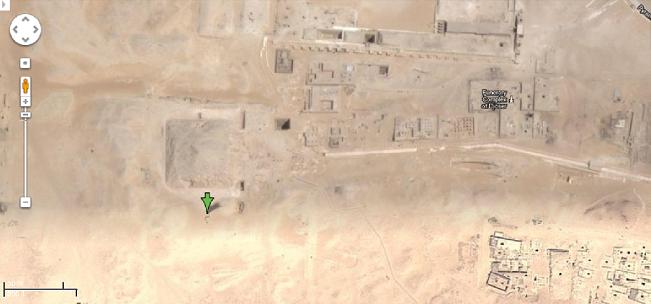 Location of the persian tombs
Location of the persian tombs
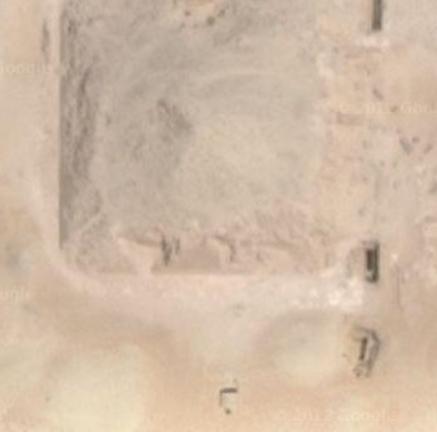
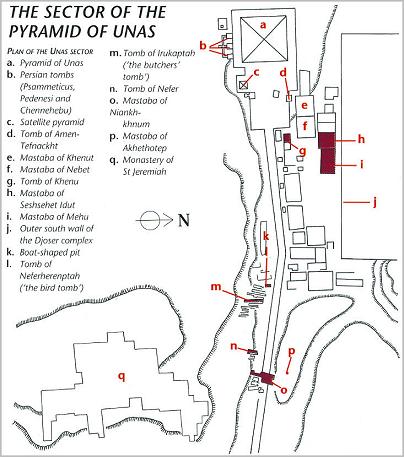
Some sources mentioning connecting tunnels constructed in modern times, this either incorrect or in relation to any of the other persian tombs (e.g. Tomb of Amen-tefnakht). The shaft was originally directly carved into the bedrock, with the purpose to "constructed in such a way in an attempt to outwit ancient tomb-robbers". Allegedly this attempt has failed and it is stated that it were tomb-robbers who had carved a spiral entrance passage.
The problem with this statement is one, the lack of verifiable information (i was unable to find a detailed report, documentation or any drawings from the Barsanti excavation, there are no pictures of shaft entrance or the steel-staircase build into the shaft by modern excavators) two, the contradicting information regarding the artifacts that have been found, especially in the Djenhebu tomb.
If the tomb was raided then the question remains why modern excavations were able to find gold pendants, inscribed cloth and so on. Whatever the case is, for the mystery at hand the question is of secondary nature, it was mainly raised to point out the difficulty to establish the facts.
To summarize, the location of the persian tombs is known, there is no confirmed second entrance, either from the surface or through connecting tunnels from other underground structures in the area. Today, the entrance is concealed by a small stone hut with an iron door.
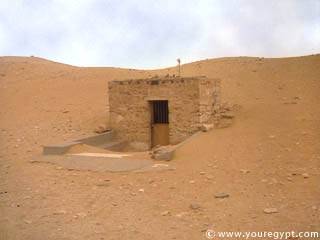
It is sometimes stated that it would be possible to access the tombs by bribing a guard, however there are no reports from people who were able to do so in recent times, most tourist information sites only giving a short notice that access is currently restricted for visitors, this has been the case for the last several years. The interior is also confirmed fact, two chambers are empty with the third chamber containing the mystery.
- Size does matter.
Until information to the contrary surfaces, the size given for the shaft is: 20m deep (vertical) 1,4m x 1,5m wide. From the bottom end of the shaft, two horizontal shafts leading to the east and to the west and after one (or resp. two) right-angle turns to the burial chambers (Pediese, Psamtik, Djenhebu - from east to west).
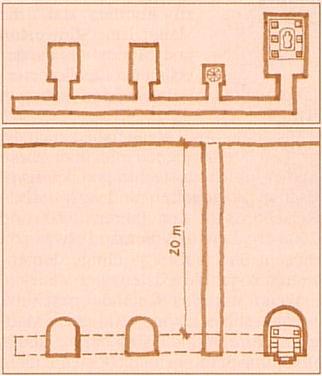
The size given for the shaft to the western chamber is: 4m long, 1,50m high and 0,80m wide. The passage directly in front of the western chamber is described to be made of limestone blocks with the door way made of large rectangular granite blocks. The sizes for the chamber itself are 3.5m high (at the highest point), 5m long and 3m wide.
Inside, on the bottom of the chamber lies a so called anthropoid sarcophagus, the outer form directly carved into the bedrock and the inner basalt sarcophagus seamlessly fitted into the form. Above it, today resting on six limestone pillars, sits a large granite monolith, which was originally lying directly on the bottom floor, on top of the sarcophagus.
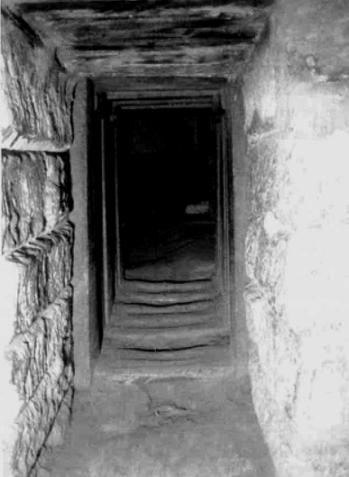 Passage/shaft into the chamber
Passage/shaft into the chamber
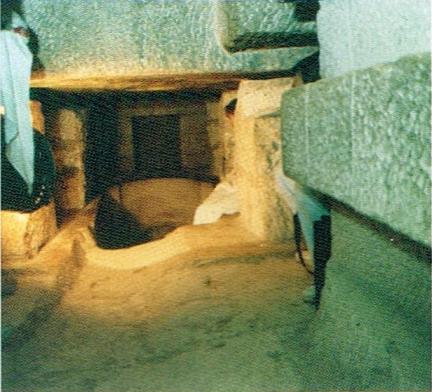 the chamber
the chamber
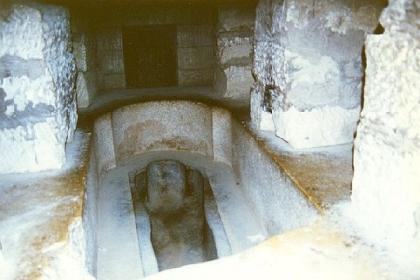
It is the existence of this monolith, inside the chamber what is making the persian tombs an unsolved mystery. If all the available information is correct, it shouldn't be there, but it is.
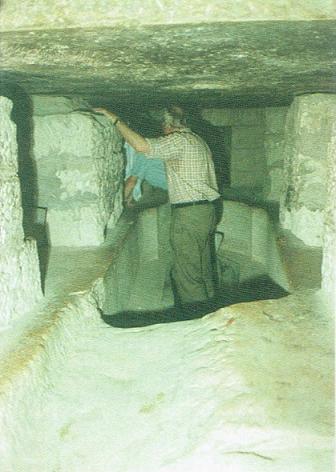
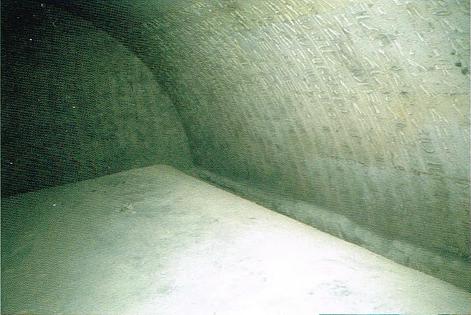 Monolith, top view
Monolith, top view
The size of the monolith: 4m long - 2.5m wide - 1.25m high with an estimated weight of 37 tons. It is almost filling out the entire chamber from left to right, but does not touch the wall on any point.
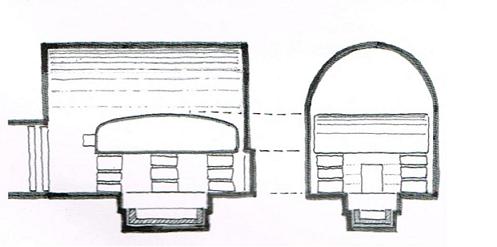
The only source confirming that it is most certainly (Assuan) rose granite, is a construction engineer who was able to visit the tombs in the late 90's. There is no other official record even discussing the existence of the stone, let alone providing any information about its substance or how it got there. The only unofficial information from a local egyptologist is the statement that the stone's material is currently being tested (date 2008).
Final summary:
In northern Saqqara, south of the Pyramid of Unas, inside a tomb 20m deep underground, lies a 37 ton monolith made of a different material than the surrounding bedrock, far to large to fit through the narrow entrance shafts (vertical and horizontal).
This mystery can be solved, if it turns out:
-There is another entrance leading directly into the chamber.
-The monolith is of the same material as the surrounding bedrock stone.
-or... Aliens.
If any of the local expert can provide additional information, it would be highly appreciated.
When i try to fathom how the AE were able to do this:

I feel a bit like a toddler trying to solve this:
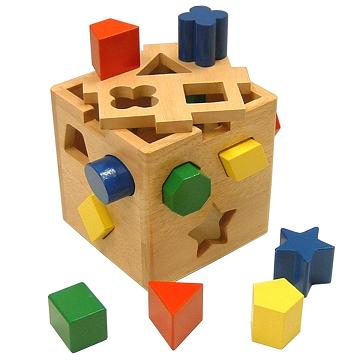
- Backround
The persian tombs ( saite tombs, persian shafts) are located to the south of the Unas Pyramid in northern Saqqara, 15km south of Giza. The tombs are attributed to three officials of 26th dynasty (late period, ca. 670-330 BC) namely, Djenhebu -‘Overseer of Royal Freight Boats’, Psamtik - ‘The Greatest of the Physicians’ and his son, Pediese - ‘Secretary of the Royal Weaving’. All of the three lived and were supposedly buried during the reign of Ahmose II. The first who excavated the tombs in modern times (early 20th century) was Alessandro Barsanti, he's also being credited with the discovery.

-Links to more backround info-
Late period tombs
Saqqara
Alessandro Barsanti
Pyramid of Unas
I will leave out any further information regarding the decoration of the burial chambers, the artifacts found etc. for now, except for the details relevant to explain the mystery.
- the Mystery
As said before, the shaft entrance is located directly to the south of the Unas Pyramid (see Satellite image & map below) and this is exactly the point from where it becomes almost impossible to provide conclusive evidence.
All (reliable) sources specify the depth of the vertical entrance shaft with 20m/82ft (in some rare cases 25m), making the tombs one of the deepest burial chambers in Egypt. The single shaft is said to be the only entrance (again, according to the sources i consider most reliable), on the Satellite images and the pictures from the surrounding area are no other shafts/entrances discernible.



Some sources mentioning connecting tunnels constructed in modern times, this either incorrect or in relation to any of the other persian tombs (e.g. Tomb of Amen-tefnakht). The shaft was originally directly carved into the bedrock, with the purpose to "constructed in such a way in an attempt to outwit ancient tomb-robbers". Allegedly this attempt has failed and it is stated that it were tomb-robbers who had carved a spiral entrance passage.
The problem with this statement is one, the lack of verifiable information (i was unable to find a detailed report, documentation or any drawings from the Barsanti excavation, there are no pictures of shaft entrance or the steel-staircase build into the shaft by modern excavators) two, the contradicting information regarding the artifacts that have been found, especially in the Djenhebu tomb.
If the tomb was raided then the question remains why modern excavations were able to find gold pendants, inscribed cloth and so on. Whatever the case is, for the mystery at hand the question is of secondary nature, it was mainly raised to point out the difficulty to establish the facts.
To summarize, the location of the persian tombs is known, there is no confirmed second entrance, either from the surface or through connecting tunnels from other underground structures in the area. Today, the entrance is concealed by a small stone hut with an iron door.

It is sometimes stated that it would be possible to access the tombs by bribing a guard, however there are no reports from people who were able to do so in recent times, most tourist information sites only giving a short notice that access is currently restricted for visitors, this has been the case for the last several years. The interior is also confirmed fact, two chambers are empty with the third chamber containing the mystery.
- Size does matter.
Until information to the contrary surfaces, the size given for the shaft is: 20m deep (vertical) 1,4m x 1,5m wide. From the bottom end of the shaft, two horizontal shafts leading to the east and to the west and after one (or resp. two) right-angle turns to the burial chambers (Pediese, Psamtik, Djenhebu - from east to west).

The size given for the shaft to the western chamber is: 4m long, 1,50m high and 0,80m wide. The passage directly in front of the western chamber is described to be made of limestone blocks with the door way made of large rectangular granite blocks. The sizes for the chamber itself are 3.5m high (at the highest point), 5m long and 3m wide.
Inside, on the bottom of the chamber lies a so called anthropoid sarcophagus, the outer form directly carved into the bedrock and the inner basalt sarcophagus seamlessly fitted into the form. Above it, today resting on six limestone pillars, sits a large granite monolith, which was originally lying directly on the bottom floor, on top of the sarcophagus.



It is the existence of this monolith, inside the chamber what is making the persian tombs an unsolved mystery. If all the available information is correct, it shouldn't be there, but it is.


The size of the monolith: 4m long - 2.5m wide - 1.25m high with an estimated weight of 37 tons. It is almost filling out the entire chamber from left to right, but does not touch the wall on any point.

The only source confirming that it is most certainly (Assuan) rose granite, is a construction engineer who was able to visit the tombs in the late 90's. There is no other official record even discussing the existence of the stone, let alone providing any information about its substance or how it got there. The only unofficial information from a local egyptologist is the statement that the stone's material is currently being tested (date 2008).
Final summary:
In northern Saqqara, south of the Pyramid of Unas, inside a tomb 20m deep underground, lies a 37 ton monolith made of a different material than the surrounding bedrock, far to large to fit through the narrow entrance shafts (vertical and horizontal).
This mystery can be solved, if it turns out:
-There is another entrance leading directly into the chamber.
-The monolith is of the same material as the surrounding bedrock stone.
-or... Aliens.
If any of the local expert can provide additional information, it would be highly appreciated.
When i try to fathom how the AE were able to do this:

I feel a bit like a toddler trying to solve this:

edit on 11-1-2013 by talklikeapirat because: rstw
edit on 11-1-2013 by talklikeapirat because: typ o
Is there any consideration the tombs were reused and could date from earlier...?
ps....please show the decoration.
ps....please show the decoration.
edit on 11-1-2013 by Kantzveldt because: (no reason given)
reply to post by Kantzveldt
No, as far as i know, official egyptology is not considering the possibilty, as it is often the case when artifacts, a cartouche or even a mummy is found that can be clearly dated to a certain time period. I read many of your threads, so i think you know how this works. But of course, i think it is always possible that a cite is older than whatever is found inside or near it.
Regarding the decoration. There are not many images i could find, one is the top view of the monolith in the OP, where the hieroglyph reliefs are visible. The relief is suppose to be a copy of pyramid texts in the royal chamber of the Unas Pyramid, the oldest religious writing found to date. Another image would be this: (from one of the now empty chambers, i'm not sure which one exactly, either the tomb of Pediese or Psamtik's)
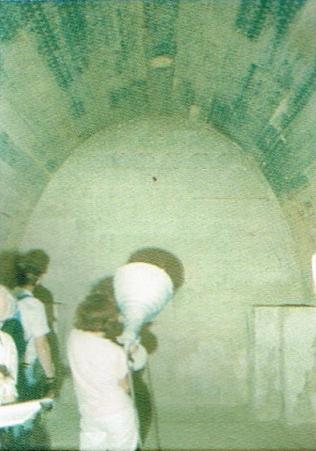
The quality is not very good, but you can find it online. The decoration is similar to that of the Unas Pyramid, only in reverse, white stars on a blue ceiling.
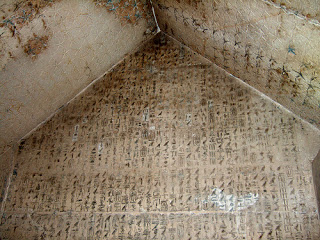 Unas Pyramid
Unas Pyramid
This is another one from the other empty chamber, supposedly Pediese's tomb, with the copied reliefs visible.
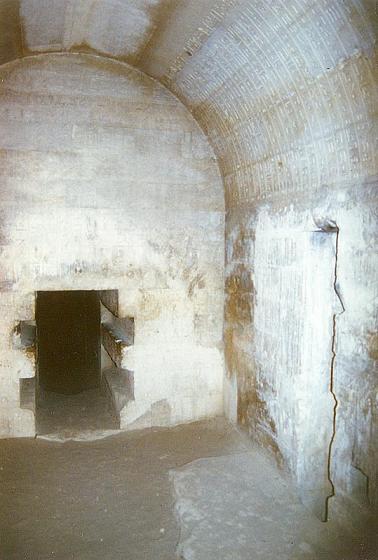
Google is not exactly your friend here, when it comes to finding any kind of detailed report about any of the excavations. There are a couple of books that could help to shed some light, none of them are available online.
Books of the dead
Is there any consideration the tombs were reused and could date from earlier...?
No, as far as i know, official egyptology is not considering the possibilty, as it is often the case when artifacts, a cartouche or even a mummy is found that can be clearly dated to a certain time period. I read many of your threads, so i think you know how this works. But of course, i think it is always possible that a cite is older than whatever is found inside or near it.
Regarding the decoration. There are not many images i could find, one is the top view of the monolith in the OP, where the hieroglyph reliefs are visible. The relief is suppose to be a copy of pyramid texts in the royal chamber of the Unas Pyramid, the oldest religious writing found to date. Another image would be this: (from one of the now empty chambers, i'm not sure which one exactly, either the tomb of Pediese or Psamtik's)

The quality is not very good, but you can find it online. The decoration is similar to that of the Unas Pyramid, only in reverse, white stars on a blue ceiling.

This is another one from the other empty chamber, supposedly Pediese's tomb, with the copied reliefs visible.

Google is not exactly your friend here, when it comes to finding any kind of detailed report about any of the excavations. There are a couple of books that could help to shed some light, none of them are available online.
Books of the dead
edit on 11-1-2013 by talklikeapirat because: (no reason given)
reply to post by talklikeapirat
Wow, that's a very good post,
You have two options, there is another entrance, hidden by the facing stones of the
passage to the chamber, where there is considerable backfill between the facing stones and the original tunnel.
Or the shaft has been refaced and recarved after the lid was placed in chamber.
In either scenario the original entrance passages were just big enough to allow the lid to pass.
I also suspect the the shape of the lid, being rounded and lozenge shaped , was from it being carved ,in transit,
to just fit through its passage.
Then everything was refaced on the way out to make the passage smaller.
Wow, that's a very good post,
You have two options, there is another entrance, hidden by the facing stones of the
passage to the chamber, where there is considerable backfill between the facing stones and the original tunnel.
Or the shaft has been refaced and recarved after the lid was placed in chamber.
In either scenario the original entrance passages were just big enough to allow the lid to pass.
I also suspect the the shape of the lid, being rounded and lozenge shaped , was from it being carved ,in transit,
to just fit through its passage.
Then everything was refaced on the way out to make the passage smaller.
reply to post by talklikeapirat
That would be very odd for the given period, pyramid texts as per the tomb of Unas, it suggests to me the tomb dates from the time of Unas, but i'll look into this more.
There is of course a way to get the slab into the tomb, that being you would have had to dig out the ground above it, lower the slab into the excavated area, construct the tomb support walls, then refill in from above.
That's a lot of work of course but possible.
In some ways this reminds me of the 'Osiris Tomb' at Giza, and i'm wondering if something similar wasn't constructed at Saqqara at the time of Unas.
If this does date from the time of Unas the other chambers would be the Ante-chamber and Serdab.
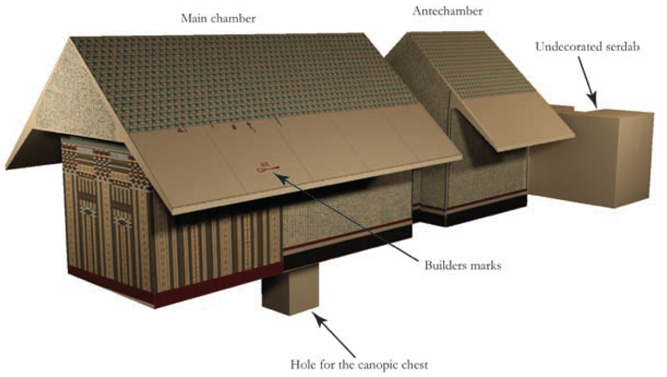
That would be very odd for the given period, pyramid texts as per the tomb of Unas, it suggests to me the tomb dates from the time of Unas, but i'll look into this more.
There is of course a way to get the slab into the tomb, that being you would have had to dig out the ground above it, lower the slab into the excavated area, construct the tomb support walls, then refill in from above.
That's a lot of work of course but possible.
In some ways this reminds me of the 'Osiris Tomb' at Giza, and i'm wondering if something similar wasn't constructed at Saqqara at the time of Unas.
If this does date from the time of Unas the other chambers would be the Ante-chamber and Serdab.

edit on 11-1-2013 by Kantzveldt because: (no reason given)
edit on 11-1-2013 by Kantzveldt because: (no reason given)
reply to post by Kantzveldt
That is exactly the point. The persian tombs are indeed very similar to the 'Osiris Tomb', with the only difference being, that the sarcophagi found in the 'Osiris Tomb' would theoretically fit through the narrow entrance passage. Interestingly, the second level of the 'Osiris Tomb' has also been dated to the late period, because 26th dynasty artifacts and pottery was found in it. Logic is not always the determining factor when it comes to dating in egyptology.
But with the monolith in the persian tombs the case is completely different, as mentioned before, the entrance shaft is directly carved into the bedrock, that has formed over millions of years, egyptologist are not disputing this fact, for the most part they simply remain silent. If the measurements are correct, and there is no reason to doubt this, the entrance is only 1.4m x 1.5m wide, going 20m deep into solid stone.
Of course it would always be possible that there is another carved out shaft, either directly above the chamber or somewhere in the close proximity. But there is no indication for any of this. If the supposed shaft wouldn't be above the chamber, then there would have to be a secret entrance tunnel leading in, from one of surrounding walls, big enough for the stone to fit through.
If it was directly above it and the stone was lowered through the ceiling of the chamber, then there would have to be some kind indication of a breach in. But there is none. In any case, until it is not determined if the monolith is really granite or not or if any kind of tunnel is found, it remains a mystery.
If you or anybody else could find additional information, it be very much appreciated.
This is how the shaft would like, only a lot smaller. (plus the iron staircase)
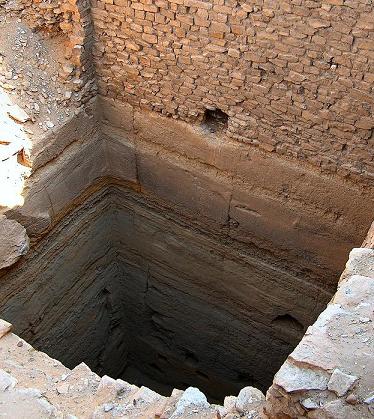
As i understand it the 'serdab' of Unas Pyramid has already been found.
There is of course a way to get the slab into the tomb, that being you would have had to dig out the ground above it, lower the slab into the excavated area, construct the tomb support walls, then refill in from above.
That's a lot of work of course but possible.
In some ways this reminds me of the 'Osiris Tomb' at Giza, and i'm wondering if something similar wasn't constructed at Saqqara at the time of Unas.
That is exactly the point. The persian tombs are indeed very similar to the 'Osiris Tomb', with the only difference being, that the sarcophagi found in the 'Osiris Tomb' would theoretically fit through the narrow entrance passage. Interestingly, the second level of the 'Osiris Tomb' has also been dated to the late period, because 26th dynasty artifacts and pottery was found in it. Logic is not always the determining factor when it comes to dating in egyptology.
But with the monolith in the persian tombs the case is completely different, as mentioned before, the entrance shaft is directly carved into the bedrock, that has formed over millions of years, egyptologist are not disputing this fact, for the most part they simply remain silent. If the measurements are correct, and there is no reason to doubt this, the entrance is only 1.4m x 1.5m wide, going 20m deep into solid stone.
Of course it would always be possible that there is another carved out shaft, either directly above the chamber or somewhere in the close proximity. But there is no indication for any of this. If the supposed shaft wouldn't be above the chamber, then there would have to be a secret entrance tunnel leading in, from one of surrounding walls, big enough for the stone to fit through.
If it was directly above it and the stone was lowered through the ceiling of the chamber, then there would have to be some kind indication of a breach in. But there is none. In any case, until it is not determined if the monolith is really granite or not or if any kind of tunnel is found, it remains a mystery.
If you or anybody else could find additional information, it be very much appreciated.
This is how the shaft would like, only a lot smaller. (plus the iron staircase)

As i understand it the 'serdab' of Unas Pyramid has already been found.
oddly enough it reminds me of a kiln for pottery heh
obviously not since no soda or glaze on the sides but it looks almost like the one i built with my professor
never heard of these tombs ...cool love this stuff
obviously not since no soda or glaze on the sides but it looks almost like the one i built with my professor
never heard of these tombs ...cool love this stuff
reply to post by talklikeapirat
Yes, just to point out that i was suggesting that the other two 'tomb' chambers of this complex could represent the Ante-chamber and Serdab of the burial chamber with the granite slab, not that they belong to Unas, were of course they are found and located, but like i said i'll be looking into it.
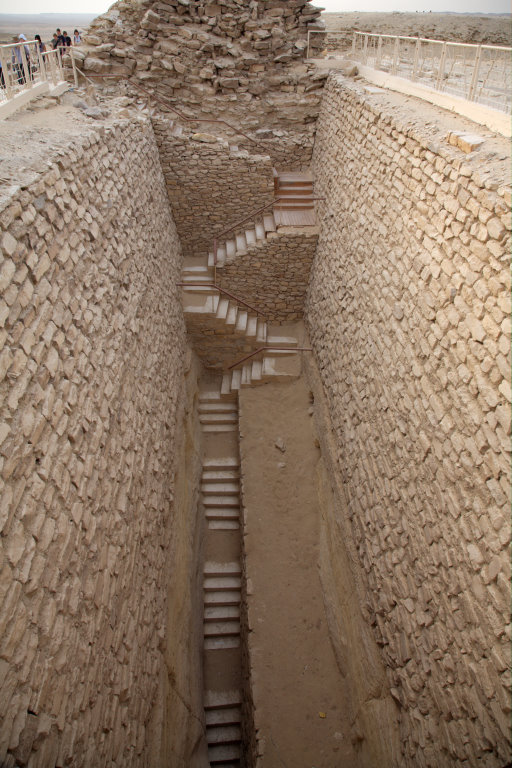
That's the spiral entrance i believe.
Yes, just to point out that i was suggesting that the other two 'tomb' chambers of this complex could represent the Ante-chamber and Serdab of the burial chamber with the granite slab, not that they belong to Unas, were of course they are found and located, but like i said i'll be looking into it.

That's the spiral entrance i believe.
edit on 12-1-2013 by Kantzveldt because: (no reason given)
reply to post by Kantzveldt
Can you imagine how long that would have taken!!! My god, look at all those cut stones!!! They are all Symmetrical, and placed so neatly. It can be a little hard to judge the size of a hole in a photograph, but those steps go a long way down, and the walls on the side are literally made from hand cut stones. Effing brilliant masonry.
I have to say though, weren't these steps suggested by Egyptologists to confuse grave robbers??? Was this stair case covered, and the entrance hidden?
OP, I have to say that's pretty remarkable structure we see here. I can't help but wonder though, if the Egyptologists didn't find the main passage. It seems many of them sort of stumble across these structures and make their own entrances where they found the tunnels. It could be possible there is an entrance tunnel that just hasn't been found. Many of these tombs seem to be sealed up pretty well. In the one photo of the entrance way to a chamber the wall is perfectly smooth on the inside, then we see what looks like a door way that was cut through the rock to get into the passage way. I can't help but notice the 4 dovetail-esque looking cuts in the stone door way. The part that puzzles me is the cut through the rock looks to be quite deep in the photo. I hate to make an estimate but it looks like 3-4 feet of solid rock it's cut into.
If it was the ancient builders of this tomb, why cut 4 dove tail holes into your door way. If it was robbed how did grave robber remove the stone plug that would have been there, it would have been immensely heavy and I doubt they could push it out. Are the chambers made of granite? What is the " Bedrock" this tomb is carved from. If we are not to believe the ancient builders cut such accurate dove tails in the door way, why did the " Discoverers " do so? Makes no sense to me to carve out the edges like that. If you're going to carve away part of an archeological find why not just carve your door way rather than risque additional damage to the structure. I'd love to get some good measurements there, it stood out to me right away.
Can you imagine how long that would have taken!!! My god, look at all those cut stones!!! They are all Symmetrical, and placed so neatly. It can be a little hard to judge the size of a hole in a photograph, but those steps go a long way down, and the walls on the side are literally made from hand cut stones. Effing brilliant masonry.
I have to say though, weren't these steps suggested by Egyptologists to confuse grave robbers??? Was this stair case covered, and the entrance hidden?
OP, I have to say that's pretty remarkable structure we see here. I can't help but wonder though, if the Egyptologists didn't find the main passage. It seems many of them sort of stumble across these structures and make their own entrances where they found the tunnels. It could be possible there is an entrance tunnel that just hasn't been found. Many of these tombs seem to be sealed up pretty well. In the one photo of the entrance way to a chamber the wall is perfectly smooth on the inside, then we see what looks like a door way that was cut through the rock to get into the passage way. I can't help but notice the 4 dovetail-esque looking cuts in the stone door way. The part that puzzles me is the cut through the rock looks to be quite deep in the photo. I hate to make an estimate but it looks like 3-4 feet of solid rock it's cut into.
If it was the ancient builders of this tomb, why cut 4 dove tail holes into your door way. If it was robbed how did grave robber remove the stone plug that would have been there, it would have been immensely heavy and I doubt they could push it out. Are the chambers made of granite? What is the " Bedrock" this tomb is carved from. If we are not to believe the ancient builders cut such accurate dove tails in the door way, why did the " Discoverers " do so? Makes no sense to me to carve out the edges like that. If you're going to carve away part of an archeological find why not just carve your door way rather than risque additional damage to the structure. I'd love to get some good measurements there, it stood out to me right away.
reply to post by Hijinx
I think that is the main entrance shaft and the vertical shaft was subsidiary;
thus a 11x8m shaft cut around 30m deep matches what we see there.
26th Dynasty tomb info and diagrams
It is very impressive construction, not sure how it could have been mistaken for a grave robbers entrance.
I think that is the main entrance shaft and the vertical shaft was subsidiary;
The main feature of these 26th Dynasty tombs is a huge rectangular shaft or pit, about 11x8m, cut about 30m deep in the bedrock. A subsidiary shaft, about 1.4m by 1.4m, is always several meters deeper than the main shaft. A burial chamber built of limestone blocks is located at the bottom of the main shaft. In fact, this "burial chamber," with its vaulted roof and square corner posts, is the outermost of a series of nesting sarcophagi. It has the shape of a sarcophagus known since the 1st Dynasty, imitating an early house form. the chamber fits closely around a huge limestone sarcophagus. Inside the limestone sarcophagus is an anthropoid sarcophagus of slate or basalt, in which is the anthropoid wooden coffin.
thus a 11x8m shaft cut around 30m deep matches what we see there.
after construction the chamber was connected to the subsidiary shaft by a small passage made of limestone slabs or vaulted mudbricks, then the large pit was filled with sand. The actual burial was conducted via the small shaft and corridor, and there is evidence of an ingenious series of devices to insure its security. The basalt sarcophagus was closed and then the lid of the large sarcophagus was lowered. The lid has square projections at the small sides, which fit into grooves in the walls of the chamber, so that the lid could be supported by wooden props resting on sand. The sand was released to a lower level through small apertures, allowing the lid to descend slowly into place. Then the pottery jars, which had plugged holes in the roof vault of the chamber, were broken and sand streamed in from the fill of the large shaft. In addition, the brick vault of the passage could be broken before the small shaft was filled. Any robbers who wanted to come near the sarcophagus, even via the small shaft, would have had to remove the entire sand fill of about 2000 cubic meters. It has been suggested that the sarcophagus, weighing up to 100 tons, was lowered in place by the sand which was filled into the large shaft. If such an operation actually took place, the downward extension of the subsidiary shaft may have played some part in the gradual removal of the sand.
26th Dynasty tomb info and diagrams
It is very impressive construction, not sure how it could have been mistaken for a grave robbers entrance.
edit on 12-1-2013 by Kantzveldt because: (no reason given)
edit on 12-1-2013 by Kantzveldt because: (no reason given)
reply to post by talklikeapirat
Awesome
These are the types of threads that attracted me to ATS in the first place. Giving this thread a well deserved S & F and bump.
Thanks for sharing.
Awesome
These are the types of threads that attracted me to ATS in the first place. Giving this thread a well deserved S & F and bump.
Thanks for sharing.
reply to post by Kantzveldt
My apologies, i wasn't sure what you exactly meant. It would be interesting to find out if the design of late period burial structures is conceptually similar to that of the 5th dynasty.
That's the entrance passage to the 'Tomb of Amen-tefnakht', located to the north-east of the Unas Pyramid or north of the Satellite pyramid. It's an entirely different structure. If you look at the map of the Unas complex, you'll see where both of them are located.
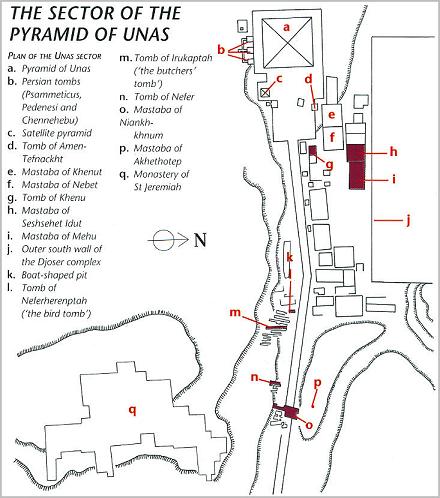
b. would be the 'persian tombs' south of the Pyramid, and
d. the 'Tomb of Amen-tefnakht'.
There is no connection between the two of them.
As i said, the only officially confirmed entrance to the 'tombs' is the one that is today covered by the little stone building. It would look quite similar to the entrance shaft of the 'Osiris Crypta' or the 'Campell Tomb' only that it has an iron staircase build in and being 20m deep.
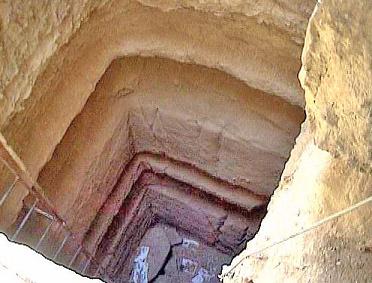
I'm still trying to find any of the official excavation records, so far with out succsess.
My apologies, i wasn't sure what you exactly meant. It would be interesting to find out if the design of late period burial structures is conceptually similar to that of the 5th dynasty.
That's the spiral entrance i believe.
That's the entrance passage to the 'Tomb of Amen-tefnakht', located to the north-east of the Unas Pyramid or north of the Satellite pyramid. It's an entirely different structure. If you look at the map of the Unas complex, you'll see where both of them are located.

b. would be the 'persian tombs' south of the Pyramid, and
d. the 'Tomb of Amen-tefnakht'.
There is no connection between the two of them.
As i said, the only officially confirmed entrance to the 'tombs' is the one that is today covered by the little stone building. It would look quite similar to the entrance shaft of the 'Osiris Crypta' or the 'Campell Tomb' only that it has an iron staircase build in and being 20m deep.

I'm still trying to find any of the official excavation records, so far with out succsess.
reply to post by talklikeapirat
You're right, i came across a couple of places saying that related to the Persian shaft tombs, but apparantly not, It would be something similar though that one would expect to have been a part of the construction process of the Persian tombs no...?
You're right, i came across a couple of places saying that related to the Persian shaft tombs, but apparantly not, It would be something similar though that one would expect to have been a part of the construction process of the Persian tombs no...?
reply to post by Kantzveldt
I agree. That's the reason my 'fringe' side is regarding this as a clear indication that the 'tombs' were not build as burial chambers in the first place, and are indeed much older, along with what you have poined out - the similarity with the decoration and hieroglyph reliefs found in the 5th dynasty Unas Pyramid.
The conservative sceptic in me keeps on insisting that only facts matter. That is why i wish one of the experts would speak out and explain this mystery to us common folks.
It would be something similar though that one would expect to have been a part of the construction process of the Persian tombs no...?
I agree. That's the reason my 'fringe' side is regarding this as a clear indication that the 'tombs' were not build as burial chambers in the first place, and are indeed much older, along with what you have poined out - the similarity with the decoration and hieroglyph reliefs found in the 5th dynasty Unas Pyramid.
The conservative sceptic in me keeps on insisting that only facts matter. That is why i wish one of the experts would speak out and explain this mystery to us common folks.
edit on 12-1-2013 by talklikeapirat because: &
I have very little knowledge on this subject.
But was wondering if this monolith has anything under it?
Could it be holding some secret to advance or help humanity?
As i have said i know little to nothing on this subject and it is very
difficult to see in the pictures to tell if it has a camber or not.
Thanks for any replies.
But was wondering if this monolith has anything under it?
Could it be holding some secret to advance or help humanity?
As i have said i know little to nothing on this subject and it is very
difficult to see in the pictures to tell if it has a camber or not.
Thanks for any replies.
new topics
-
Thanking a rosemary plant
General Chit Chat: 49 minutes ago -
Unidentified Flying Objects Over U.S. Military Bases in Northeast UK, as of roughly 11 a.m. CST.
Aliens and UFOs: 1 hours ago -
Holy Cow! Erm...Six Legged Turkey!!
World Sports: 5 hours ago -
Ben Habib has Left Reform UK
Regional Politics: 8 hours ago -
Turkey Day Rhyme…
Short Stories: 9 hours ago -
Can someone please translate Biden's speech?
US Political Madness: 9 hours ago -
NIH Chief Confesses COVID Initiatives Were "Completely Made Up " OMG Investigates
Health & Wellness: 10 hours ago
top topics
-
NIH Chief Confesses COVID Initiatives Were "Completely Made Up " OMG Investigates
Health & Wellness: 10 hours ago, 9 flags -
Vladimir Putin's speech at the meeting of the CSTO Collective Security Council
World War Three: 13 hours ago, 8 flags -
Can someone please translate Biden's speech?
US Political Madness: 9 hours ago, 8 flags -
Unidentified Flying Objects Over U.S. Military Bases in Northeast UK, as of roughly 11 a.m. CST.
Aliens and UFOs: 1 hours ago, 7 flags -
Awesome Dip Recipe
Food and Cooking: 13 hours ago, 5 flags -
Turkey Day Rhyme…
Short Stories: 9 hours ago, 5 flags -
Ben Habib has Left Reform UK
Regional Politics: 8 hours ago, 4 flags -
Holy Cow! Erm...Six Legged Turkey!!
World Sports: 5 hours ago, 2 flags -
Thanking a rosemary plant
General Chit Chat: 49 minutes ago, 0 flags
active topics
-
Holy Cow! Erm...Six Legged Turkey!!
World Sports • 4 • : JJproductions -
Why isn't Psychiatry involved?
Social Issues and Civil Unrest • 17 • : lilzazz -
Unidentified Flying Objects Over U.S. Military Bases in Northeast UK, as of roughly 11 a.m. CST.
Aliens and UFOs • 2 • : Texastruth2 -
Traveling the world with no passport
Social Issues and Civil Unrest • 12 • : andy06shake -
The Party of Peace - Trump Cabinet Picks Targeted with Death Threats
US Political Madness • 46 • : chr0naut -
Thanking a rosemary plant
General Chit Chat • 1 • : nugget1 -
V.P. Kamala Harris releases a video and nobody understands why
US Political Madness • 91 • : xuenchen -
Happy Thanksgiving to ATS
General Chit Chat • 14 • : randomtangentsrme -
Vladimir Putin's speech at the meeting of the CSTO Collective Security Council
World War Three • 62 • : annonentity -
Awesome Dip Recipe
Food and Cooking • 6 • : Flyingclaydisk
32
